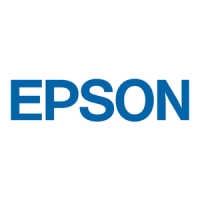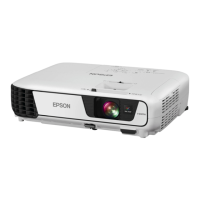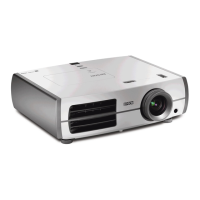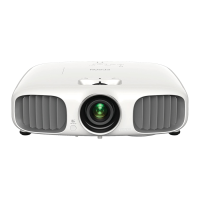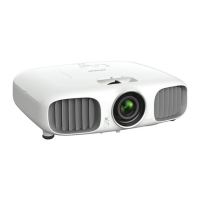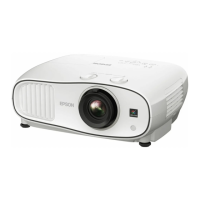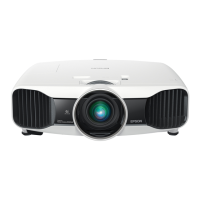Do you have a question about the Epson PowerLite Home Cinema 2000 and is the answer not in the manual?
Lists key features of the projector including resolution, 3D projection, and connectivity.
Details the labels and functions of the remote control buttons.
Provides instructions for connecting various video devices to the projector.
Details how to connect a video source using an HDMI cable for best image quality.
Step-by-step guide on powering on the projector and connected devices.
Instructions on how to properly shut down the projector and its components.
Explains how to display slideshows from USB devices.
Details how to adjust image quality settings like Color Mode, Brightness, and Contrast.
Explains how the projector automatically optimizes input signals and how to customize them.
Options in the Settings menu for customizing various projector features.
Customizing projector setup features like Operation, Display, Input Signal, and Language.
Setting up the projector for monitoring and control over a network.
Routine maintenance tasks like cleaning the lens, air filter, and vents.
Importance of regular filter maintenance to prevent overheating and ensure longevity.
Indicators for lamp replacement and information on tracking lamp hours.
Detailed steps for safely replacing the projector lamp, including cooling precautions.
Guides on troubleshooting issues related to projected images or audio output.
Troubleshooting steps for when the projector displays no image.
Steps to resolve the "No Signal" message by checking connections and sources.
Troubleshooting for "Not Supported" messages related to input signal or resolution.
Steps to fix issues where only part of the computer image is displayed.
How to resolve projected image issues with electronic interference or static.
Troubleshooting steps for fuzzy or blurry projected images.
How to fix issues with image brightness being too dark/light or incorrect colors.
Guides on resolving issues with no sound or incorrect volume levels.
Troubleshooting issues with projector or remote control operation.
Troubleshooting steps for projector not turning on or shutting off unexpectedly.
How to troubleshoot issues where the projector does not respond to remote control commands.
Displays basic technical specs like resolution, lens, color reproduction, and brightness.
Technical details about the projector lamp, including type, power, and life.
General safety cautions regarding projector lens, electrical voltage, and lamp handling.
Detailed safety guidelines for setting up and using the projector to prevent injury or damage.
Lists key features of the projector including resolution, 3D projection, and connectivity.
Details the labels and functions of the remote control buttons.
Provides instructions for connecting various video devices to the projector.
Details how to connect a video source using an HDMI cable for best image quality.
Step-by-step guide on powering on the projector and connected devices.
Instructions on how to properly shut down the projector and its components.
Explains how to display slideshows from USB devices.
Details how to adjust image quality settings like Color Mode, Brightness, and Contrast.
Explains how the projector automatically optimizes input signals and how to customize them.
Options in the Settings menu for customizing various projector features.
Customizing projector setup features like Operation, Display, Input Signal, and Language.
Setting up the projector for monitoring and control over a network.
Routine maintenance tasks like cleaning the lens, air filter, and vents.
Importance of regular filter maintenance to prevent overheating and ensure longevity.
Indicators for lamp replacement and information on tracking lamp hours.
Detailed steps for safely replacing the projector lamp, including cooling precautions.
Guides on troubleshooting issues related to projected images or audio output.
Troubleshooting steps for when the projector displays no image.
Steps to resolve the "No Signal" message by checking connections and sources.
Troubleshooting for "Not Supported" messages related to input signal or resolution.
Steps to fix issues where only part of the computer image is displayed.
How to resolve projected image issues with electronic interference or static.
Troubleshooting steps for fuzzy or blurry projected images.
How to fix issues with image brightness being too dark/light or incorrect colors.
Guides on resolving issues with no sound or incorrect volume levels.
Troubleshooting issues with projector or remote control operation.
Troubleshooting steps for projector not turning on or shutting off unexpectedly.
How to troubleshoot issues where the projector does not respond to remote control commands.
Displays basic technical specs like resolution, lens, color reproduction, and brightness.
Technical details about the projector lamp, including type, power, and life.
General safety cautions regarding projector lens, electrical voltage, and lamp handling.
Detailed safety guidelines for setting up and using the projector to prevent injury or damage.
| Number of colors | 1.073 billion colors |
|---|---|
| Native aspect ratio | 16:9 |
| Projection distance | 2 - 6 m |
| Projection technology | 3LCD |
| Supported aspect ratios | 4:3, 16:10 |
| Contrast ratio (typical) | 13000:1 |
| Screen size compatibility | 34 - 328 \ |
| Projector native resolution | 1080p (1920x1080) |
| Keystone correction, horizontal | 30 ° |
| Focus | Manual |
| Optical zoom | 1.2 x |
| Zoom capability | Yes |
| Focal length range | 16.9 - 20.28 mm |
| Aperture range (F-F) | 1.58 - 1.72 |
| Lamp type | UHE |
| Lamp power | 200 W |
| Lamps quantity | 1 lamp(s) |
| Light source type | Lamp |
| Service life of light source | 5000 h |
| Service life of light source (economic mode) | 6000 h |
| Video processing | 10 bit |
| Supported video modes | 1080i, 1080p, 480i, 480p, 576p, 720p |
| Analog signal format system | NTSC, NTSC 4.43, PAL, PAL 60, PAL M, PAL N, SECAM |
| Supported graphics resolutions | 1920 x 1080 (HD 1080) |
| DVI port | No |
| USB connector type | USB Type-A |
| Serial interface type | RS-232 |
| USB 2.0 ports quantity | USB 2.0 ports have a data transmission speed of 480 Mbps, and are backwards compatible with USB 1.1 ports. You can connect all kinds of peripheral devices to them. |
| S-Video inputs quantity | 0 |
| Card reader integrated | - |
| Noise level | 37 dB |
| RMS rated power | 2 W |
| Placement | Desktop, Ceiling |
| Product type | Standard throw projector |
| Product color | Grey, White |
| Market positioning | Home cinema |
| Cable lock slot type | Kensington |
| Power source | AC |
| AC input voltage | 100 - 240 V |
| Voltage tolerance | 10 % |
| AC input frequency | 50 - 60 Hz |
| Power consumption (standby) | 0.36 W |
| Power consumption (typical) | 283 W |
| Power consumption (PowerSave) | 234 W |
| Operating temperature (T-T) | 5 - 35 °C |
| Depth | 246.8 mm |
|---|---|
| Width | 296.9 mm |
| Height | 107.9 mm |
| Weight | 2902 g |

